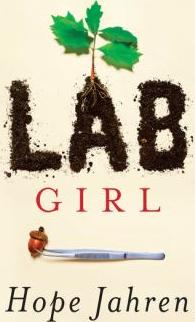
Lab girl
Available Copies by Location
| Location | |
|---|---|
| Victoria | Available |
Other Formats
Browse Related Items
- ISBN: 9781410490780
- Physical Description 513 pages (large print) ; 23 cm.
- Edition Large print edition.
- Publisher [Place of publication not identified] : [publisher not identified], 2016.
Content descriptions
| General Note: | GMD: large print. |
| Bibliography, etc. Note: | Includes bibliographical references. |
Series
Additional Information

New York Times Review
Lab Girl : A Story of Trees, Science and Love
New York Times
June 3, 2016
Copyright (c) The New York Times Company
LARGE NUMBERS AMAZE; numbers of large numbers amaze even more. Cognitive neuroscience can explain why (numbers of a certain opulence can be grasped only conceptually, and thus stupefy) but it takes a passionate geobiologist with the soul of a poet to make us really swoon in the face of computational amplitude. Science is in the end a love affair with numbers, and when it comes to botany, the "numbers are staggering," Hope Jahren writes in her spirited account of how she became an eminent research scientist. "Lab Girl" lets loose with a salvo of stunning numbers in its first paragraph: The mass ratio of plants to animals on land is a thousand to one, and the average plant on land is a two-ton tree that lives for more than a century. There are more than 200 trees to each human in the United States - some 80 billion trees in national parks alone. "Since I've discovered these numbers," Jahren writes, "I can see little else." We can see why. An aim of hers is to make the reader appreciate the fascinations of studying flora, to infect us with the same enthusiasm that has driven her ever since she was a child hanging around in her professor father's lab, falling hard for the sensuous allures of the slide rule. Early on she discovers one generous mystery of scientific inquiry - in the course of making it, it makes you: "A true scientist doesn't perform prescribed experiments, she develops her own and thus generates wholly new knowledge." Jahren's literary bent renders dense material digestible, and lyrical, in fables that parallel personal history. "A tree's wood is also its memoir," and the first leaf that unfurls from a seed "is a new idea," like those a scientist investigates to establish a career. Trees need to meet their "annual budgets" for growth just as an academic must secure funding, over and over. And willows, "the Rapunzel of the plant world," continually shed bits that take root downstream in genetic replicas - inseparable, like Jahren and her lab partner Bill, a character every bit as extraordinary as any of the wild organisms she describes. The sardonic Bill, of Armenian extraction, enters her life when she's a graduate student at Berkeley and proceeds to enliven both it and her narrative for the remainder. When writing about a symbiotic fungus that permits a tree to grow where it otherwise might fail or the constancy of the light cycle that sets off protective hardening against the winter freeze, she is invoking their friendship. Both scientists are natural loners, but together are lonely no more. They build labs at three universities; on occasion Bill takes up residence in them, when he's not living in a van, that is. He is funny, hard-bitten, loyal and achingly touching: After Jahren marries and has a son, she hopes Bill too will find love. He dismisses the notion by observing that since Armenians often live to 100, at not yet 50 he's too young to date. If her use of allegory to make science approachable verges on pat, Jahren can be forgiven, for it allows her to deliver a gratifying and often moving chronicle of the scientist's life. She also earns her license to issue warnings we would do well to heed. Jahren is determined we stop taking trees for granted. They are a miracle 300 million years in the making. That they are still around is testimony to their ingenious powers of survival. Or perhaps to our inability - yet - to destroy every last one, though not for lack of trying: We are on track to rid the planet of trees within 600 years. So plant one tree this year, Jahren implores. "Becoming a tree is a long journey," she writes, a sometimes perilous one, as a great majority - 95 percent - will not live past their second year. So too is the road to becoming a scientist, and especially a female one; sexism in science is a major theme of the book. Trees nourish life in uncountable, always beautiful, ways, and to plant one is to plant hope. MELISSA HOLBROOK PIERSON is the author of five books, most recently "The Secret History of Kindness."


